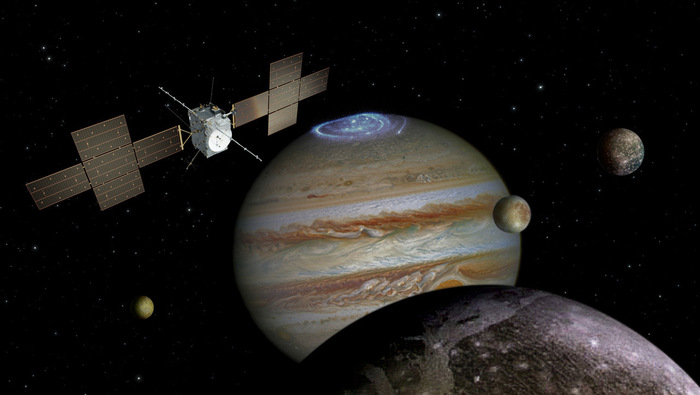The Juice probe is preparing to leave Europe for the Kurou base (French Guiana), from where it is scheduled to launch towards Jupiter in April, which it should reach in 2030. The mission's objective are the moons Ganymede, Europa and Callisto, which under their frozen surface they could hide oceans capable of hosting life forms.
On board the European Space Agency (ESA) probe, a plaque dedicated to Galileo Galilei, who discovered the large moons of Jupiter in 1640, and 11 instruments, three of which were financed and developed under the guidance of the Italian Space Agency (ASI). .
From the establishments in Toulouse, where the tests were completed, the Juice probe (Jupiter Icy Moon Explorer) was presented today before leaving for Kourou.
In particular, the commemorative plaque was presented which contains some pages of the Sidereus Nuncius, the book in which Galileo Galilei had described the moons of Jupiter Io, Europa, Ganymede and Callisto.
"After so many years of work, it is always a unique emotion to finally see all the instruments mounted on board for the last checks before being transported to the launch pad," said Giuseppe Piccioni, research director of the National Institute of Astrophysics ( Inaf) and scientific director of the agreement between ASI and Inaf for the Italian participation in the mission.
Juice's goal is to study the conditions for the formation of planets and the appearance of life, considering that the icy moons of Jupiter could represent an environment potentially capable of supporting life forms for a long time.
Of the 11 Juice instruments, supplied by seven countries, the greatest contribution is from Italy, with the Janus camera system created with the Parthenope University of Naples at Leonardo's factories in Campi Bisenzio (Florence), the Rime radar created with the University of Trento and Thales Alenia Space, which will scan under the ice and 3Gm, developed with the Sapienza University of Rome, which will measure the extent of hidden seas.
Added to these is the strong Italian participation in the Majis spectrometer (Moons and Jupiter Imaging Spectrometer) led by the French space agency Cnes and for which Leonardo supplied the hyperspectral optical head to study clouds, ice and minerals on the surfaces of the three moons.
Italy has also collaborated with NASA's Jet Propulsion Laboratory (JPL) and with the German space agencies DLS, French CNS and Israeli ISA to create the instruments.
The Italian contribution to the Juice mission "represents the state of the art both from a technological and scientific point of view. We are convinced that the joint efforts made in recent years will lead us to surprising results never achieved before and will strengthen the leadership role achieved by Italy in many sectors of planetary exploration", observes Angelo Olivieri, ASI delegate to the Juice Steering Committee.
The Juice tools also involve, for Italy, the offices of Rome, Teramo and Padua of the National Institute of Astrophysics (INAF), the Universities of Trento, Sapienza of Rome, Roma Tre, Bologna, Rome Tor Vergata, Geosciences Institute and Georisorse (Igg) of the National Research Council (Cnr), Partenope of Naples, of Salento, Cisas - University of Padua, Polytechnic of Milan, Fondazione Bruno Kessler (Fbk).
Lastly, Juice's solar panels were born in the Leonardo plant in Nerviano (Milan), the largest ever built for an interplanetary mission, with an area of 85 square meters to supply the electrical power needed at a distance of over 750 million kilometers from the Sun.

